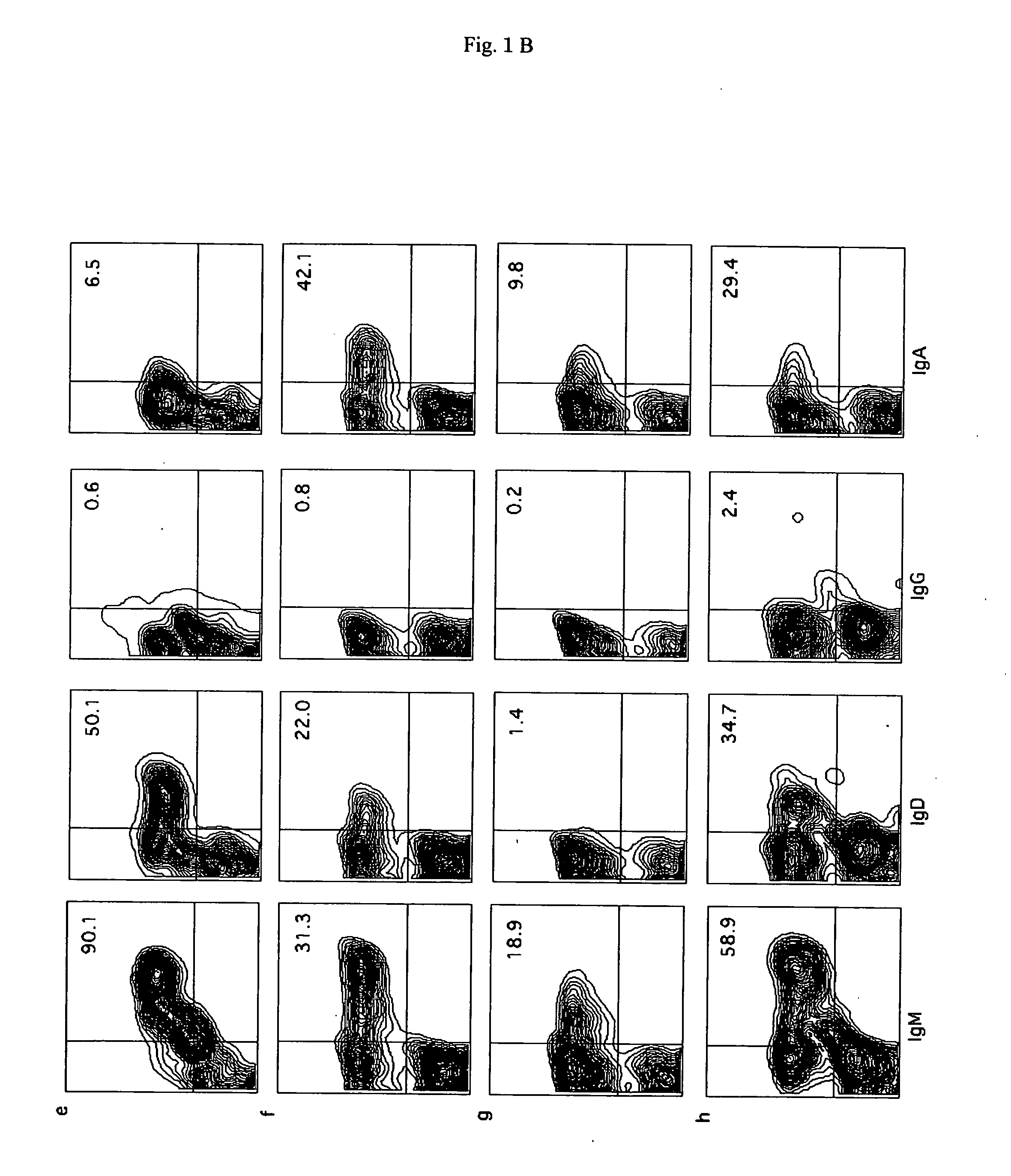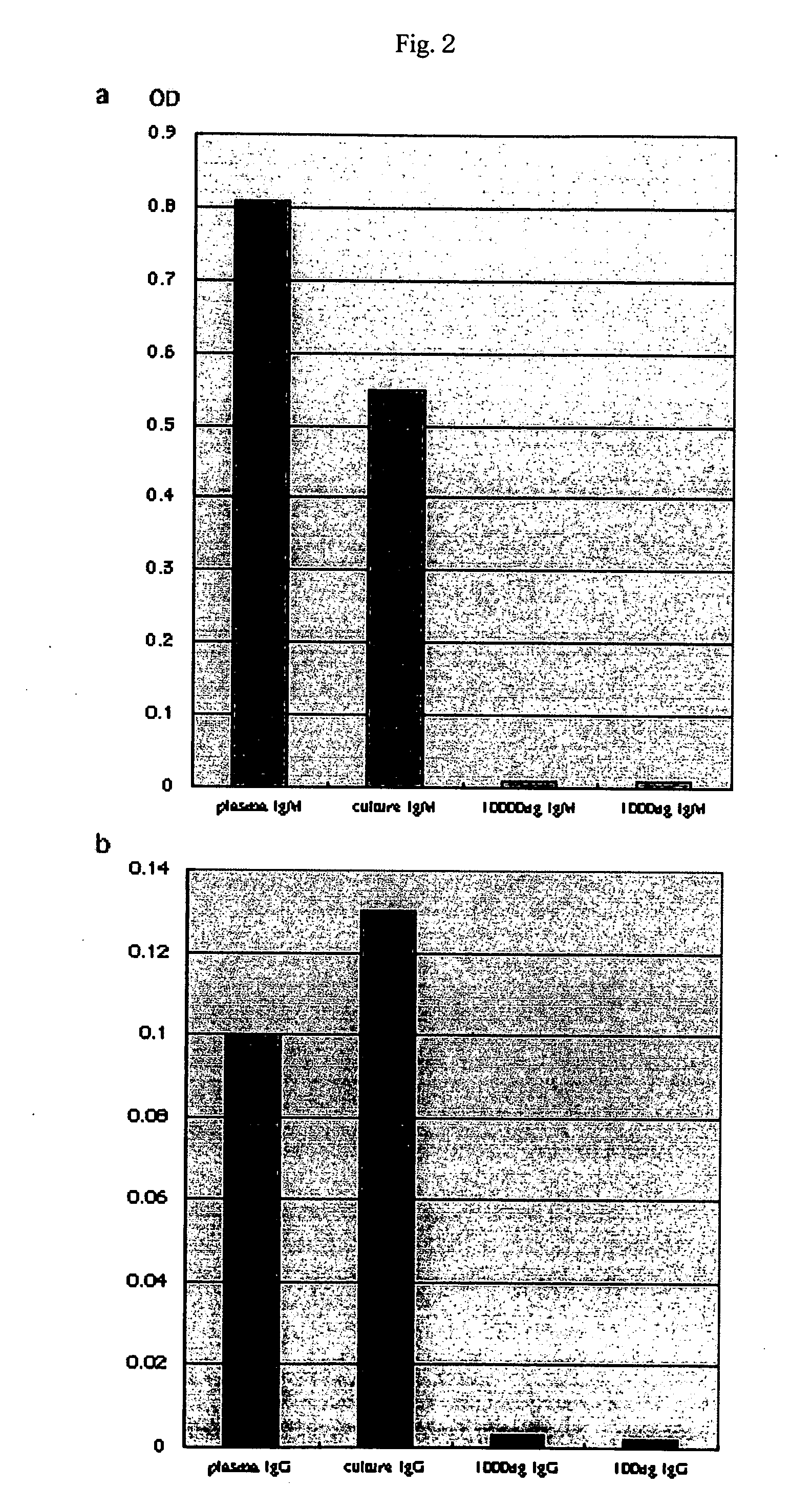Process for producing human-origin immunocompetent cell
a technology of immunocompetent cells and human origin, which is applied in the field of human immunocompetent cell production, can solve the problems of difficult to distinguish t cells from precursor cells, and achieve the effect of reducing the difficulty of t cells to differentia
- Summary
- Abstract
- Description
- Claims
- Application Information
AI Technical Summary
Benefits of technology
Problems solved by technology
Method used
Image
Examples
example 1
Transplantation of Human Hematopoietic Cells into Immunodeficient Mice
[0076] Cord blood (CB) cells were obtained from the Metro Tokyo Red Cross Cord Blood Bank. After obtaining written informed consent, CB cells were collected from cord blood to be wasted. Thereafter, monocytes (MNCs) were isolated from the CB in a density gradient manner (lymphocyte isolation medium, ICN Biomedicals) by centrifugation at 370×g for 30 minutes. The obtained MNCs were then incubated together with mouse anti-human CD3, CD4, and CD8 antibodies (BD Immunocytometry) at 4° C. for 30 minutes. After washing, the cells were incubated together with sheep anti-mouse immunomagnetic beads (DINAL) at 4° C. for 30 minutes, so as to recover unbound cells. In order to isolate a CD34+ population, T cell-eliminated sample was incubated together with anti-human CD34 microbeads (Miltenyi Biotech) for 40 minutes (in accordance with protocols provided by manufacturers). The cells were passed through a magnetic column twic...
example 2
Analysis of Human-Derived B Lineage Cells in Living Bodies of Mice
[0078] In order to examine the presence or absence of reconstruction of human lymph cells in the living bodies of mice, multiple analyses of hematopoietic tissues were conducted in terms of the transplantation level of CD19+cells (B cells) that are human CD45+cells.
[0079] After transplantation, recipient mice were bred for 3 months, and on the 3rd month, it was analyzed regarding whether or not human-derived B lineage cells existed in the bone marrow (BM), spleen, peripheral blood (PB), and lymph nodes (LN) of the recipient mice. The BM, spleen, PB, and LN were stained with FITC-binding immunoglobulin and PE-binding CD19.
[0080] The results are shown in FIGS. 1A and 1B. In FIG. 1A, a, b, c, and d represents the flow cytometry of cells collected from the BM; the spleen; the PB; and the LN, respectively. In each of lymphoid tissues, human CD45+CD19+ cells were identified at a high level. Each of the numerical values s...
example 3
Differentiation and Maturation of B Lineage Cells
[0085] Using a cell sorter, human CD19+ cells (B cells) were collected from the peripheral blood (PB), bone marrow (BM), and spleen of recipient mice, and the expression of IgM, IgG, IgD, and IgA in the B cells was examined. The surface expression of IgM / IgD in the CD19+ cells was 90.0% / 54.0% in the case of PB, 19.7% / 3.4% in the case of BM, and 59.0% / 22.7% in the case of spleen.
[0086] Using pokeweed mitogen (PWM), the spleen cells were further cultured in a test tube for 5 days. In addition, recipient mice immunized with 100 μg / ml of OVA were also produced. Subsequently, secretion of human immunoglobulins into the culture supernatant and blood plasma was examined by ELISA (Table 1). After completion of the culture with PWM for 5 days, the medium (supernatant) contained 114 ng / ml to 19.8 μg / ml of IgM, 2.6 to 47.6 ng / ml of IgG, and 1.9 to 5.7 ng / ml of IgA (Table 1).
TABLE 1Generation of human immunoglobulinsSamplePlasma / immunogenIgMI...
PUM
| Property | Measurement | Unit |
|---|---|---|
| time | aaaaa | aaaaa |
| compositions | aaaaa | aaaaa |
| cell surface | aaaaa | aaaaa |
Abstract
Description
Claims
Application Information
 Login to View More
Login to View More - R&D
- Intellectual Property
- Life Sciences
- Materials
- Tech Scout
- Unparalleled Data Quality
- Higher Quality Content
- 60% Fewer Hallucinations
Browse by: Latest US Patents, China's latest patents, Technical Efficacy Thesaurus, Application Domain, Technology Topic, Popular Technical Reports.
© 2025 PatSnap. All rights reserved.Legal|Privacy policy|Modern Slavery Act Transparency Statement|Sitemap|About US| Contact US: help@patsnap.com



